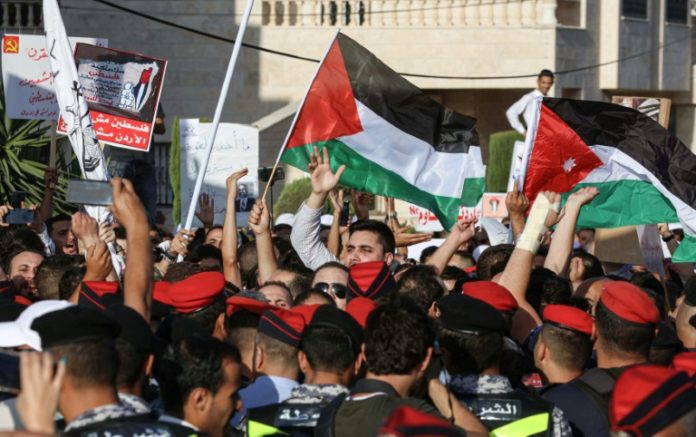WASHINGTON, June 23, 2019 (BSS/AFP) – The United States said Saturday that
its Middle East peace plan to be presented next week in Bahrain aims to raise
more than $50 billion for the Palestinians and create one million jobs for
them within a decade.
Unveiling details for the first time of its long-awaited peace initiative,
President Donald Trump’s administration said it was looking to attract
unprecedented international investment to the Palestinians and to
dramatically improve infrastructure, education and internal governance in the
West Bank and Gaza Strip.
The conference Tuesday and Wednesday in Bahrain, led by Trump’s son-in-law
and adviser Jared Kushner, is the opening of the US government’s delayed
peace effort, which officials say will later include a political component.
But the Palestinian Authority is boycotting the so-called Peace to
Prosperity workshop and a senior official swiftly rejected the plan, charging
that the unabashedly pro-Israel Trump is seeking to buy off the Palestinians
and deprive them of an independent state.
The White House cast the plan — to be discussed in more detail in Bahrain
with finance chiefs of oil-rich Gulf Arab states — as “the most ambitious
and comprehensive international effort for the Palestinian people to date.”
“For too long the Palestinian people have been trapped in inefficient
frameworks of the past,” Kushner said in a statement.
“The Peace to Prosperity plan is a framework for a brighter, more
prosperous future for the Palestinian people and the region and a vision of
what is possible if there is peace,” he said.
The White House said the plan aimed to raise more than $50 billion over a
decade, with a goal of more than doubling Palestinian gross domestic product.
The White House said the initiative had the power to create more than one
million Palestinian jobs — bringing the unemployment rate down to the single
digits, in line with developed economies — and reduce the poverty rate by 50
percent.
It said that money would be administered by a multinational development
bank — not the Palestinian Authority — as a way to ensure better governance
and prevent corruption.
– Palestinian ire –
Senior Palestinian official Hanan Ashrawi quickly rejected the plan,
saying the United States should instead press Israel to allow the
Palestinians to thrive.
“First lift the siege of Gaza, stop the Israeli theft of our land,
resources and funds, give us our freedom of movement and control over our
borders, airspace, territorial waters etc. Then watch us build a vibrant
prosperous economy as a free and sovereign people,” she tweeted.
The Palestinian leadership is deeply distrustful of Kushner, a family
friend of Israeli Prime Minister Benjamin Netanyahu, and Trump, who has taken
a series of landmark steps to support Israel including recognizing bitterly
divided Jerusalem as its capital.
US officials have hinted that the political part of the plan — which
could come out as late as November, after Israel holds new elections and
forms a government — will not mention the creation of an independent
Palestinian state, a goal of decades of US diplomacy.
Israeli Energy minister Yuval Steinitz, a member of Netanyahu’s right-wing
Likud Party considered close to the premier, voiced support for Kushner’s
plan.
“It looks good. We’re always in favor of developing the Palestinian
economy and for the end of the humanitarian crisis,” he told Israel’s Channel
13.
“Everyone in the world wants to help the Palestinians except for the
Palestinians themselves,” he added.
– Improving infrastructure, governance –
After spending more than two years working on the plan, Kushner offered a
framework full of specifics — even lauding the ice cream of Ramallah in a
section on promoting tourism.
But it remains unclear who will pay the bill for the Peace to Prosperity
plan and whether Gulf Arabs — who have increasingly found common cause with
Israel due to their mutual hostility toward Iran — will be willing to
contribute even before a political settlement.
The economic plan said it also aimed to assist the Gaza Strip, despite the
Israeli blockade of the crowded and impoverished territory due to its control
by the militant group Hamas.
Projects include a $590 million upgrade of Gaza’s main power plant —
which the White House said would create tens of thousands of jobs and provide
reliable energy for the first time in years — and $500 million to build a
world-class university in either Gaza or the West Bank.
It also called for a major push to develop tourism and some $900 million
in grants to improve roads, cargo terminals and border crossings to link the
Palestinian economy to its Arab neighbors — but not to Israel, which has
sought a physical separation from the territories.



